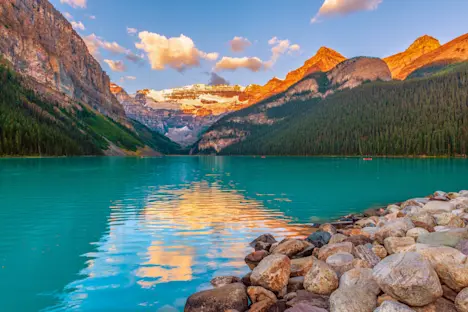Why Should I Go to the Galapagos Islands?
The Galapagos Islands rank among the world’s most extraordinary wildlife destinations. Straddling the equator about 600 miles off the coast of Ecuador, this remote volcanic archipelago harbors species found nowhere else on Earth—marine iguanas basking on black lava shores, giant Galapagos tortoises lumbering through misty highlands and blue-footed boobies nesting on sandy trails just steps from your feet.
A Living Laboratory of Evolution
Designated a UNESCO World Heritage Site, the Galapagos has captivated naturalists for centuries. Most famously, in 1835, a young Charles Darwin sailed here aboard the HMS Beagle, gathering insights that would inspire his revolutionary theory of evolution by natural selection. Today, travelers follow in his footsteps, discovering the same unspoiled ecosystems that shaped scientific history.
Land of Fire and Life
The islands themselves are a dramatic mosaic of active volcanoes, lava fields, mangroves and highland cloud forests. Hiking across these raw landscapes feels like stepping back in time, with each island offering a unique blend of habitats. Birdwatchers marvel at waved albatross, flightless cormorants, and Darwin’s finches, while wildlife photographers capture surreal vistas of red-sand beaches, cactus forests, and lunar-like craters.
An Oceanic Wonderland
Equally mesmerizing is the life beneath the waves. The Galapagos Marine Reserve—one of the largest and most biodiverse in the world—teems with underwater wonders. Snorkelers and divers encounter sea lions pirouetting through turquoise shallows, penguins darting like silver torpedoes, and even gentle green sea turtles grazing on sea grass beds. The nutrient-rich currents also attract hammerhead sharks, manta rays, and dazzling schools of tropical fish, creating a marine spectacle unmatched anywhere else.
A Journey Into the Wild
Every moment in the Galapagos feels like a front-row seat to nature’s drama. One day you may walk among nesting iguanas on Espanola; the next, kayak alongside golden rays at sunrise or watch a frigatebird inflate its crimson throat pouch in a dazzling courtship display. Few places on Earth allow such intimate, up-close encounters with wildlife—all set against a backdrop of stark volcanic beauty.
Why Choose Nat Hab for a Galapagos Adventure?
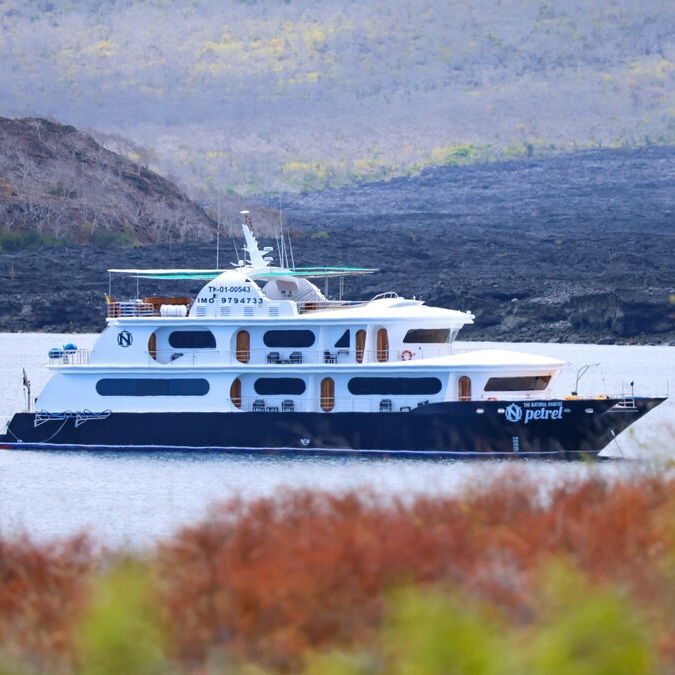
Nat Hab’s Galapagos trips feature small groups, top naturalist guides, private yachts, exclusive Tortoise Camp stays and immersive wildlife encounters.
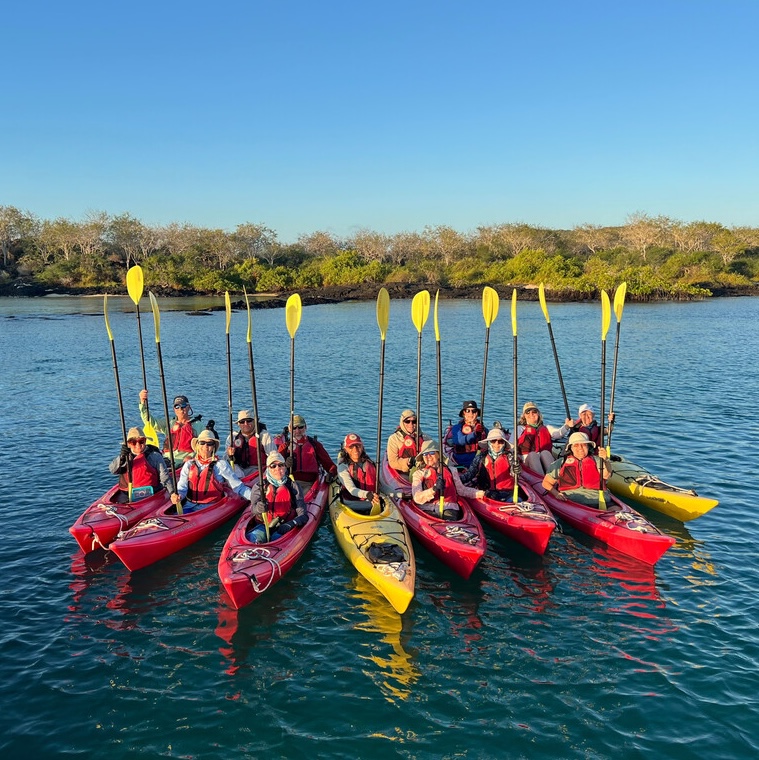
Enjoy the best guide-to-guest ratio: two expert Expedition Leaders for 14–16 guests, ensuring personal attention and rich naturalist interpretation.
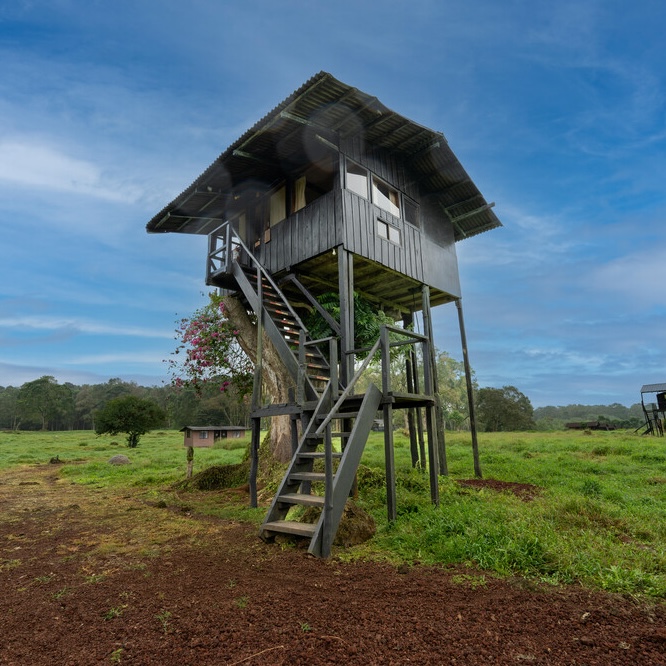
When not aboard our luxury yacht, enjoy Nat Hab's Tortoise Camp on Santa Cruz Island, sleeping among giant tortoises in unique platform tents or treehouses.
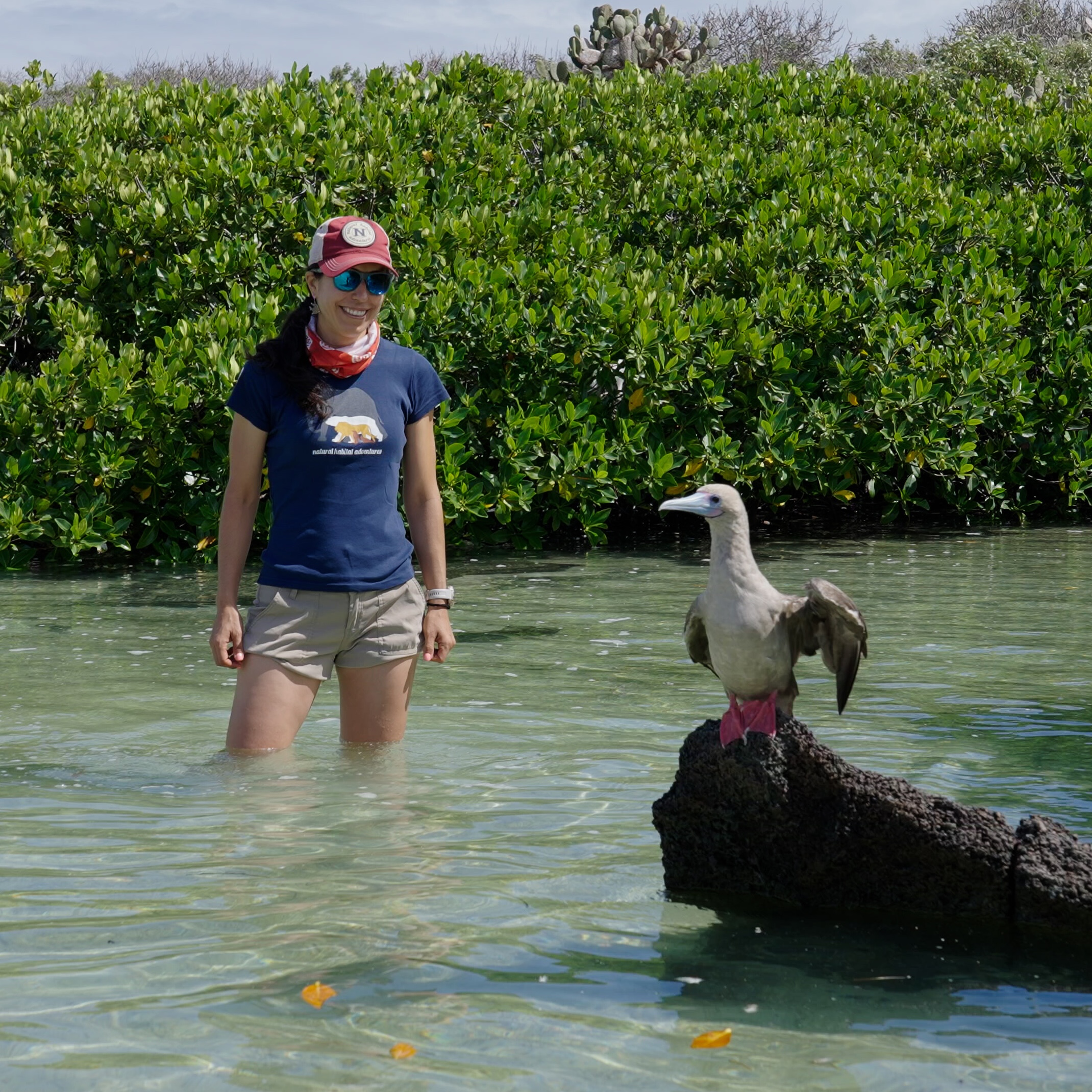
Each trip is led by two Nat Hab Expedition Leaders, the Galapagos’ best, with WWF training for unmatched expertise and personalized exploration.
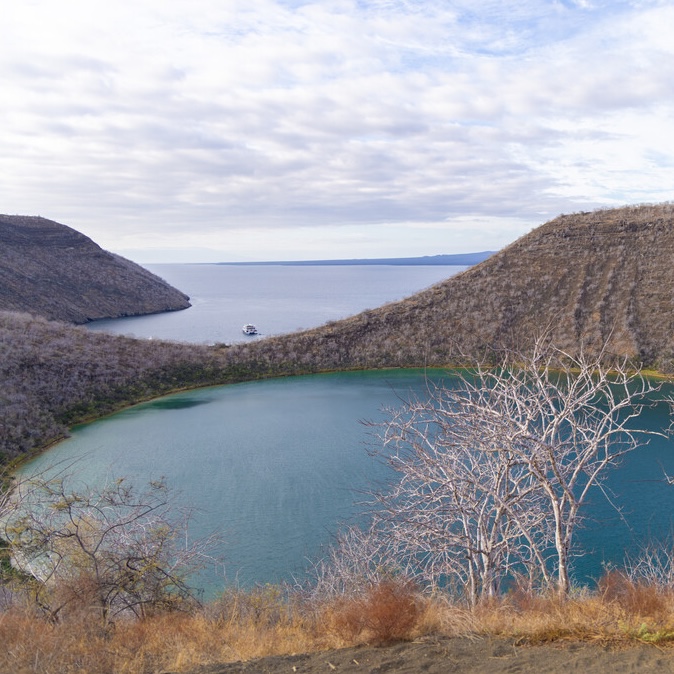
Through our WWF partnership, Nat Hab journeys protect wildlife, habitats and communities—advancing global conservation via sustainable, life-affirming adventures.
Galapagos Islands Tour Guide
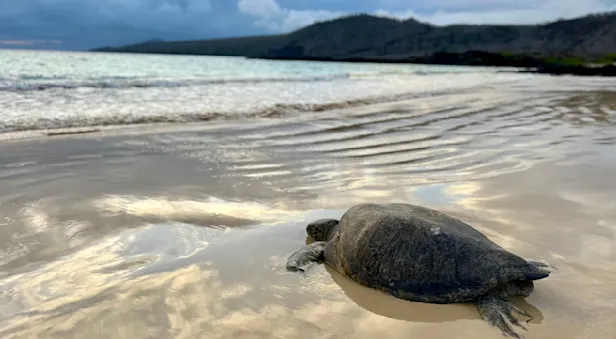
Where Should I Go on a Galapagos Islands Tour?
The Galapagos comprises 13 main islands and dozens of islets, each with its own character. Rather than a single “best” island, every one contributes to the archipelago’s extraordinary diversity
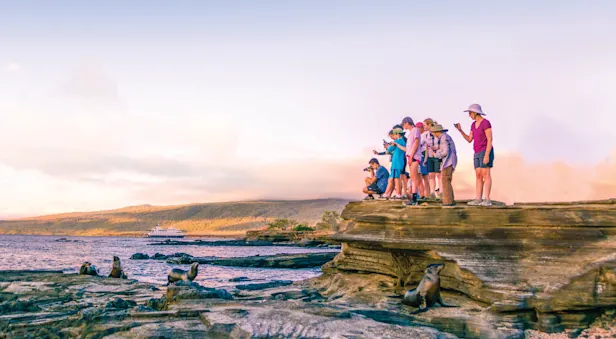
When Should I go on a Galapagos Islands Tour?
The Galapagos is a year-round destination, a living landscapes that continuously evolves, offering travelers a dynamic, ever-changing window into nature at any time of year
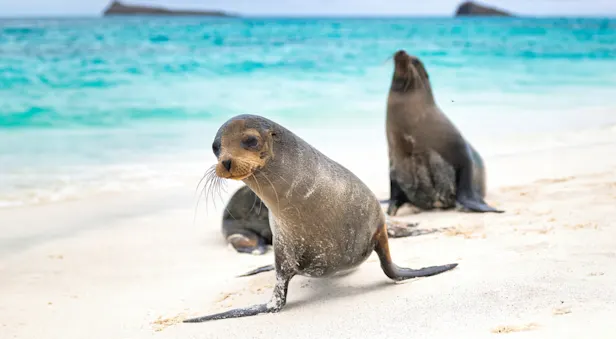
What Wildlife Will I See on a Galapagos Tour?
In the Galapagos, wildlife greets you up close: giant tortoises, marine iguanas, blue-footed boobies, finches, penguins, sea turtles, sharks, rays, sea lions and more
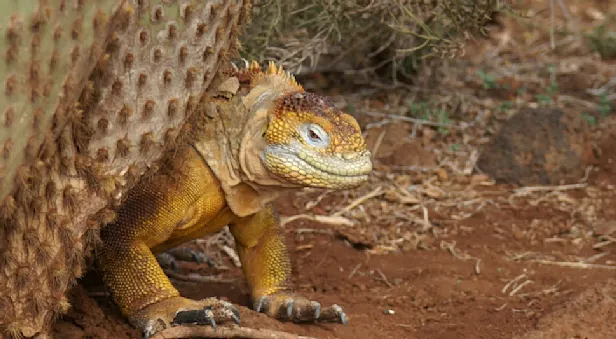
Galapagos Wildlife Seasonality
Check out our month-by-month guide of seasonal wildlife. Abundant wildlife is always present in the Galapagos Islands, and special highlights are spread throughout the year.
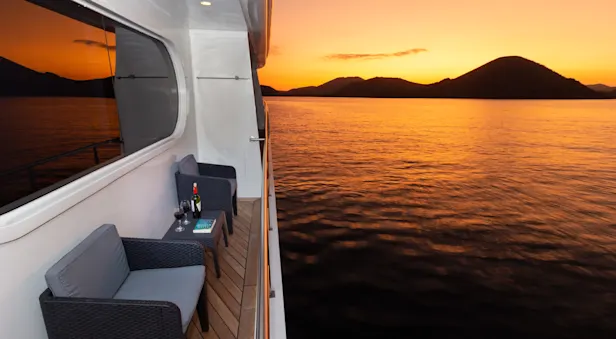
Where Will I stay on a Galapagos Tour?
Accommodations in the Galapagos are as distinctive as its islands and include private chartered yachts, larger expedition ships and land-based stays like Nat Hab's exclusive Tortoise Camp
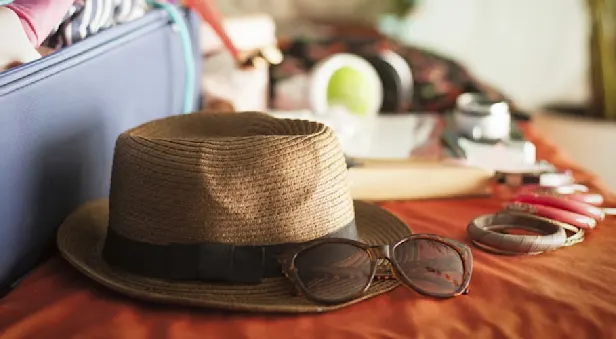
Packing List
Our comprehensive packing guide covers everything you'll need for a Galapagos Islands adventure, from sun hats to sport sandals and everything in between.
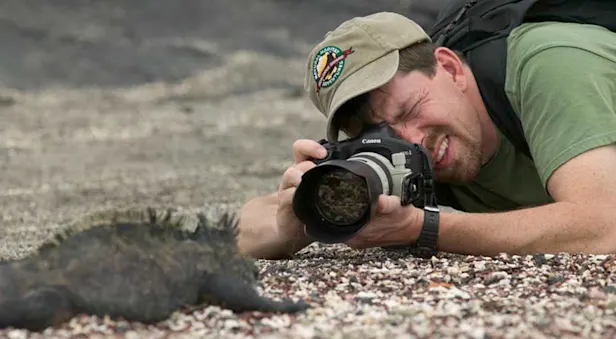
Photography Tips
Whether you're an experienced photographer or just getting started, you'll want to read these essential photo tips from our Natural Photographer blog before your Galapagos adventure.
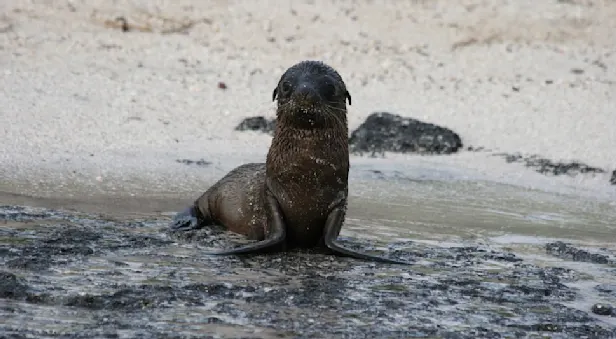
Conservation & Community
We are proud to be involved in the following initiatives throughout the Galapagos archipelago and the communities present there, as well as in parts of mainland Ecuador we visit on our adventures.
Visiting the Galapagos Islands
Top Reasons to Visit the Galapagos:
Rare Wildlife Up Close – Walk among blue-footed boobies, marine iguanas and giant tortoises, species found only in the Galapagos. Snorkel alongside sea lions, sea turtles, rays and tropical fish in clear Pacific waters.
Volcanic Landscapes – Explore lava tunnels, black-sand beaches and ancient calderas shaped by ongoing volcanic activity. Hike across dramatic terrain formed by millions of years of geologic change.
Year-Round Travel – With warm temperatures and active wildlife throughout the year, the Galapagos Islands can be visited anytime.
Family-Friendly – Galapagos adventures are accessible, enriching and enjoyable for all generations.
Conservation-Focused – This is a UNESCO World Heritage Site with strict protections for biodiversity. Visitor limits, regulated itineraries and tourism dollars help sustain rare species and fragile ecosystems.
Photographer’s Paradise – Capture dramatic landscapes and intimate wildlife moments. With close animal encounters and ever-changing natural light, this is one of the best wildlife photography destinations in the world.
What Makes the Galapagos Special for Nature Travelers?
The Galapagos is one of the world’s last truly wild places. Animals here have evolved without predators and show little fear of humans. They are unbothered by visitors who walk among nesting seabirds, snorkel beside sea lions and observe courtship dances at remarkably close range.
Strict protections limit development, and 97% of the islands are part of Galapagos National Park. The archipelago is also a UNESCO World Heritage Site, ensuring its exceptional biodiversity is preserved for future generations.
Where are the Galapagos Islands Located?
The Galapagos Islands are located about 600 miles off the coast of Ecuador in the Pacific Ocean. Most travelers arrive by air via mainland Ecuador, with flights departing daily from Quito and Guayaquil. From there, it’s a short hop to Baltra or San Cristobal, the islands’ main airports—your gateway to this extraordinary archipelago.
How Long Should I Spend in the Galapagos?
Travelers should plan to spend 6 to 8 days in the Galapagos Islands. This allows enough time to explore multiple islands and habitats. Be sure to factor in transfer days between mainland Ecuador and the archipelago when planning your trip.
Can I visit Quito When I go to the Galapagos?
Most Galapagos trips begin on mainland Ecuador, and Quito is a popular gateway city. Many travelers choose to spend a night or two exploring its historic Old Town, a UNESCO World Heritage Site known for colonial architecture, mountain views and vibrant markets.
What’s the Difference Between a Galapagos Cruise and Staying on the Islands?
Galapagos Cruise
Your ship is your basecamp, visiting new islands each day
Travel in small groups by panga, foot or snorkel
Access more remote visitor sites via night travel
Comfortable cabins, guided excursions and nightly naturalist briefings
Ideal for travelers seeking a more immersive experience
Land-Based Stay
Stay in a hotel or ecolodge on an inhabited island
Take day trips by boat to nearby sites
No nighttime motion, more comfort for some travelers
Fewer islands visited, more time spent commuting
Best for those who prefer a stationary base
What’s the Difference Between Eastern and Western Galapagos Itineraries?
Eastern itineraries focus on the older, more eroded islands in the archipelago, with rich seabird colonies, striking cliffs and accessible visitor sites. These routes often offer classic landscapes and wildlife.
Western itineraries visit the younger volcanic islands, known for dramatic lava flows, marine diversity and active geology. These routes offer some of the best opportunities for rare wildlife sightings.
What to Expect | Western Itineraries | Eastern Itineraries |
|---|---|---|
Islands Visited | Includes islands like Isabela, Fernandina, Rabida and parts of Santiago | Includes islands like Española, San Cristobal, Santa Fe and South Plaza |
Wildlife | Galapagos penguins, flightless cormorants, marine iguanas and whales | Waved albatross (seasonally), red- and blue-footed boobies and sea lions |
Landscapes | Active volcanoes, lava fields and nutrient-rich waters that support abundant marine life | Cliffs, beaches and blowholes with excellent hiking and snorkeling |
What’s the Difference Between Short and Long Galapagos Itineraries?
Short Itineraries (4–6 days)
Less geographical breadth and fewer islands visited
Best for travelers with limited time
May focus on only one region (Eastern or Western)
Long Itineraries (7–15 days)
Greater variety of landscapes, wildlife and snorkeling sites
Reach remote islands like Fernandina or Genovesa
Likely to visit more islands for in-depth exploration
Frequently Asked Questions
What’s the best island to visit in the Galapagos?
There’s no single “best” island—each has its own highlights. That’s why Nat Hab’s trips are designed to visit multiple islands, offering diverse wildlife, landscapes and snorkeling opportunities. Some standout islands in the Galapagos include:
Isabela
Fernandina
Santa Cruz
Española
Genovesa
Floreana
Santiago
North Seymour
How big are Nat Hab’s Galapagos ships, and how many guests are on board?
Nat Hab's luxury private chartered yachts carry just 14–16 guests, offering a quiet, personalized experience far from the crowds. Combining comfort, style and exclusivity with unmatched access to the islands’ wonders, our yachts are reserved solely for our guests. Each yacht features elegant accommodations, spacious decks, gourmet dining and modern amenities designed for both relaxation and adventure. With small group sizes, guests enjoy closer connections with our expert Expedition Leaders and fellow travelers. Sailing aboard these luxurious yachts offers the ideal balance of refined comfort and authentic Galapagos exploration.
What type of food will be served on a Galapagos adventure?
The food on a Galapagos adventure will feature a mix of Ecuadorian cuisine and familiar international dishes. Most Galapagos cruises and tours include all meals, prepared fresh daily using local ingredients.
Typical meals include:
Breakfast: Tropical fruit, eggs, toast, Ecuadorian coffee, fresh-squeezed juice and local specialties like green plantains or cheese empanadas
Lunch: Grilled fish, chicken or vegetables, coconut rice, fresh salads
Dinner: Appetizer or soup, followed by seafood, meat or vegetarian entrees with seasonal sides, and a light dessert like flan
Vegetarian and other special diets are usually accommodated with advance notice.
How many guides are on each trip?
Nat Hab Galapagos adventures offer the best guide-to-guest ratio in the islands, with roughly one guide for seven to eight guests. This is important for the best naturalist-guided experience of the islands.
Guide-to-guest ratios in the Galapagos vary by operator, with some trips offering just one guide for a large group and others providing more personalized attention. For the most enriching Galapagos vacation, look for a low guide-to-guest ratio—ideally one guide for every 7 to 8 guests. This allows for better wildlife interpretation, smoother logistics and a more meaningful experience overall.
Can I stay on land as well as on a boat in the Galapagos?
Yes, several Galapagos Islands are inhabited and offer land-based accommodations, including small inns and local guiding services. Some trips combine land stays with boat excursions to reach more remote islands.
What is Nat Hab’s Tortoise Camp?
Nat Hab's Tortoise Camp is a private retreat in the highlands of Santa Cruz Island where giant tortoises roam freely. Guests spend an exclusive night in raised canvas tents or treehouse-style accommodations, surrounded by wild tortoise habitat and views of the distant Pacific.
What should I pack for a Galapagos tour?
For a Galapagos tour, pack lightweight clothing, sun protection and a bathing suit for warm days on the water. Bring warmer layers and rain gear for windy or wet conditions. You'll also need sports sandals for wet landings and sturdy shoes for walks and hikes.
Can I snorkel in the Galapagos?
The Galapagos offers some of the best snorkeling on the planet. The convergence of warm and cool ocean currents creates rich marine habitats with incredible diversity. Snorkelers may see sea lions, sea turtles, penguins, rays, reef sharks and colorful fish in clear, shallow waters.
Do I need a wetsuit?
Wetsuits are recommended, and most tour operators provide full gear including masks, fins and snorkels.
Can I kayak or paddleboard in the Galapagos?
Kayaking and paddleboarding offer a unique way to explore the islands. Paddle beside sea turtles and glide past curious sea lions.
Do I need kayaking experience to join a Galapagos trip?
No prior kayaking experience is necessary. Expert guides will provide instruction and ensure a safe, accessible paddling experience for all comfort levels.
Will I get seasick on a Galapagos cruise?
Seasickness is possible, as ocean conditions vary. Most cruising happens at night while guests are asleep, which helps minimize motion discomfort. Travelers prone to motion sickness should bring medication as a precaution.
Can I scuba dive in the Galapagos?
Yes, scuba diving in the Galapagos is available through specialist operators.
How difficult is the hiking in the Galapagos?
Hikes in the Galapagos are generally easy. Travelers should be able to walk up to two miles over uneven, rocky or sandy terrain, often in warm conditions.
Are Galapagos tours suitable for older travelers or people with limited mobility?
Yes, Galapagos tours are suitable for older travelers or those with limited mobility, with some considerations. Guests should be able to walk on uneven terrain and handle boat transfers.
Are Galapagos cruises family-friendly?
The Galapagos Islands make an ideal family vacation, with up-close wildlife encounters that captivate kids and adults alike.
How rough are the seas in the Galapagos? Is seasickness common on small ships?
The waters around the Galapagos Islands are usually calm, but conditions can vary depending on weather and ocean currents. During rough weather or when a yacht is traveling against the current, seas can become choppy. The Humboldt Current, which flows north from Antarctica, brings cooler water and stronger swells from July through December, with the roughest conditions often occurring in September and October.
Because most Galapagos cruises travel between islands at night, seasickness is usually minimal. However, motion sickness can still affect some travelers. Many guests prefer to take seasickness medication as a preventative measure. If you know you are prone to motion sickness—or even if you are unsure—it’s best to pack remedies such as Dramamine, Bonine, or natural alternatives like ginger. Boats generally do not keep extra medication on board, so bringing your own supply is strongly recommended.
Galapagos travel tip: Even if you rarely experience motion sickness, it’s wise to be prepared. Packing seasickness remedies ensures your trip is comfortable, allowing you to fully enjoy wildlife encounters, snorkeling, and island excursions without disruption.ravelers fly from Quito or Guayaquil, Ecuador, to the Galapagos Islands, where they meet their ship and crew.
Do I need any vaccinations to visit the Galapagos?
There are no special vaccine requirements for the Galapagos beyond routine immunizations.
Do I fly into Quito or Guayaquil to get to the Galapagos Islands?
Most Galapagos trips begin with a flight into mainland Ecuador, either to Quito or Guayaquil. From there, travelers continue to the islands by air. Some itineraries include time to explore the historic capital of Quito or the coastal city of Guayaquil before heading to the Galapagos. Flights and park permits are arranged in advance to keep the journey hassle-free.
Why should I travel to the Galapagos with Natural Habitat Adventures?
If you want to experience the Galapagos, Nat Hab's small-ship journeys offer the most immersive encounter with the islands you'll find anywhere. Here's how we do the Galapagos differently—and best:
Just 14-16 travelers led by two or three Expedition Leaders, for the best guide-to-guest ratio in the islands. Most operators use just one guide. We give you more flexibility, individual attention and quieter wildlife encounters with only seven or eight travelers.
Chartered luxury yachts offer the ultimate in comfort and access to more remote spots
Only with Nat Hab, spend a night at our private Tortoise Camp in tent cabins or treehouses
Learn from the Galapagos' most highly trained guides, who average of 15 years of experience
A wide range of activities that includes snorkeling, kayaking, paddleboarding, panga excursions and nature walks
Exclusive itineraries are developed with WWF biologists for immersive wildlife experiences
Are park fees and permits included in the trip cost?
Your trip to the Galapagos price includes all required national park and transit control fees, which Nat Hab secures on your behalf before your adventure begins.
I want to stay and explore more of Ecuador—can Nat Hab help me plan a trip extension?
Absolutely. Nat Hab offers custom trip extensions to places like Ecuador’s Amazon Basin. Our team can tailor post-cruise travel to match your interests.
Galapagos Islands Tours
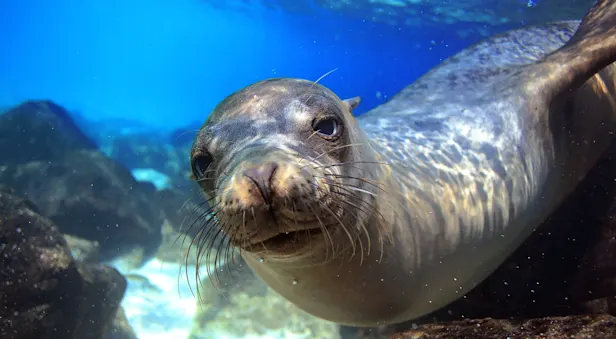
Galapagos Discovery: The Nat Hab Experience
Small-group adventures aboard your choice of private yachts, led by our outstanding naturalist guides and photography pros. Snorkel and swim with sea lions, sea turtles and penguins on this incomparable nature odyssey.
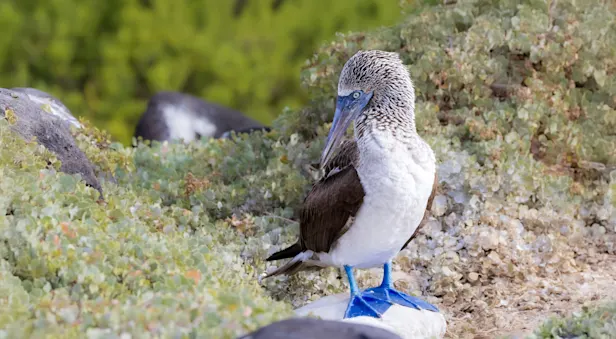
Galapagos Wildlife Photo Expedition
The ultimate Galapagos photography adventure! Capture amazing wildlife close-ups as we explore 15 diverse islands in 17 days—plus an overnight among wild giant tortoises at our private Tortoise Camp.
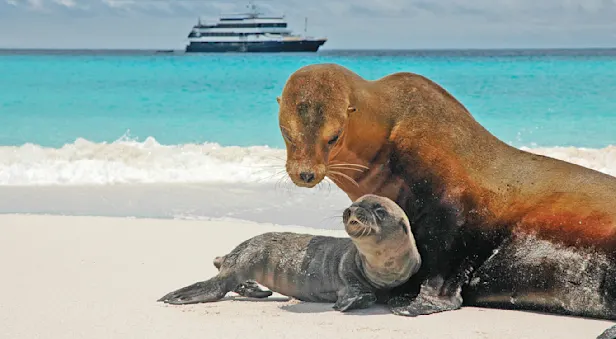
Galapagos Escape
Explore the unique habitats of the Galapagos, encounter its legendary wildlife, and enjoy active pursuits from hiking and snorkeling to paddleboarding on this expedition ship adventure
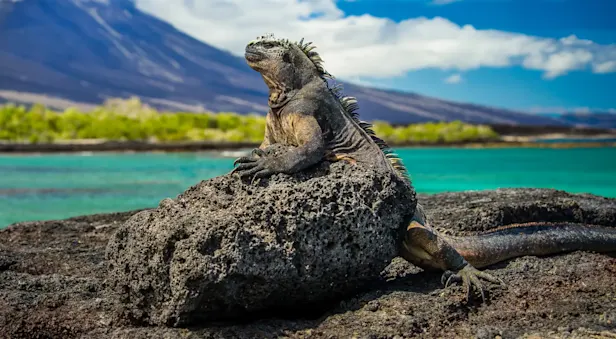
Galapagos by Catamaran: An Intimate Voyage
Experience the Galapagos aboard Lindblad Expeditions' most intimate vessel in its island fleet, a luxury motorsailing catamaran for just 16 guests.
Travel Stories
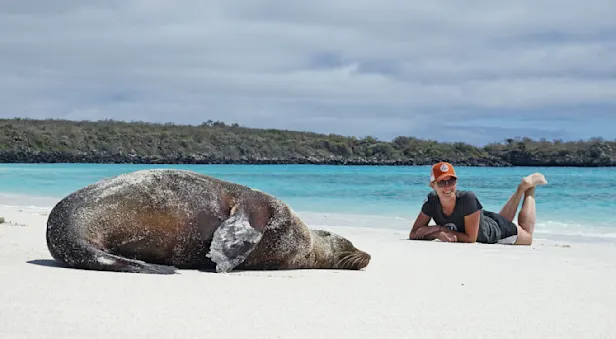
Why the Galapagos Is My Happy Place
—By Tracy Schuh
This special place in the Pacific Ocean with coordinates around 0°0°0° beamed with a flourishing ecosystem, delighted my soul in a profoundly epic way and reminded me what is possible if we make choices that protect these wild places on our beautiful planet. To quote Charles Darwin, “The love for all living creatures is the most noble attribute of man.”
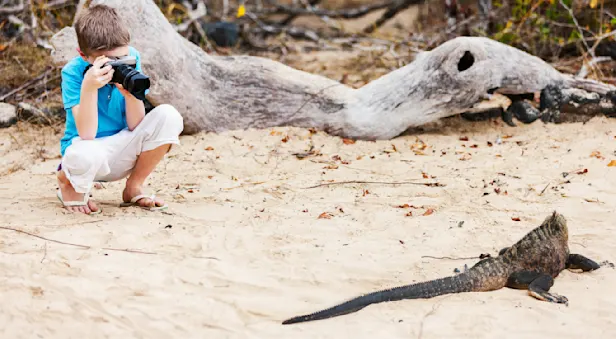
The Galapagos Islands with Kids: Where History, Geology and Conservation Come to Life
—By Cathy Brown
I’m convinced that there may be no nature destination on the planet quite as unique as the Galapagos Islands. And to be able to spend time with my enthusiastic son was an absolutely priceless experience that we will be talking about for decades to come.
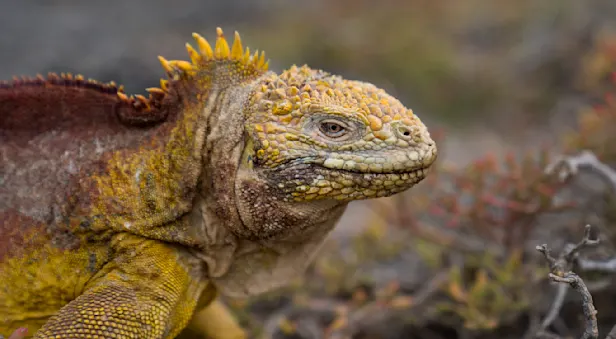
Galapagos Species That Are Back from the Brink
—By Samantha Miller
New initiatives in the Galapagos are seeking to rediscover and reintroduce species lost to climate change and human activity like the Fernandina giant tortoise that was found after 113 years of ‘extinction.’

The Mystery of Charles Darwin’s Missing Manuscripts Has Been Solved!
—By Megan Brief
Discover the contents of Darwin's missing notebooks, including his famous ‘Tree of Life’ illustration from 1837!
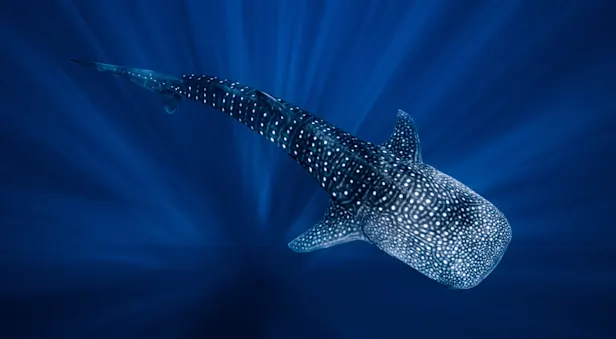
Safeguarding Migration Routes from Ecuador to Costa Rica with the Creation of the Hermandad Marine Reserve
—By Megan Brief
Recognizing that the long-term coexistence of humanity and wildlife requires a sustainable balance, Ecuador's President announced the creation of the Hermandad Marine Reserve, a migratory superhighway that connects the Galapagos Marine Reserve to protected Costa Rican waters.






